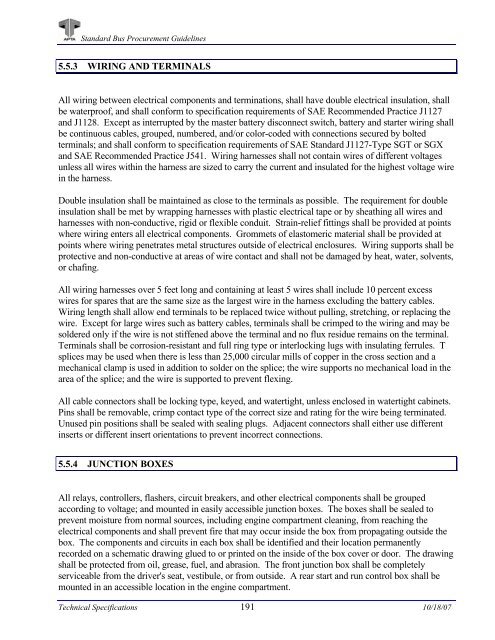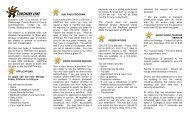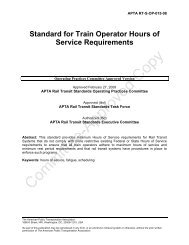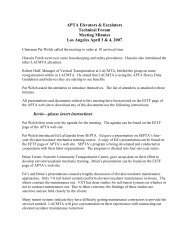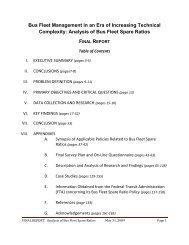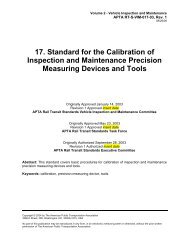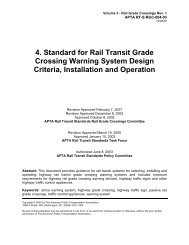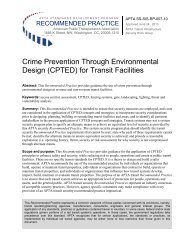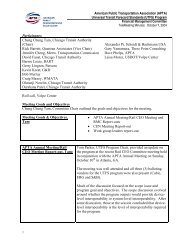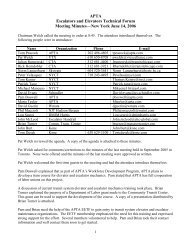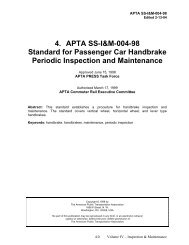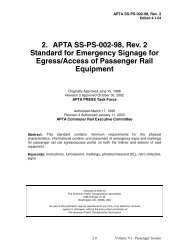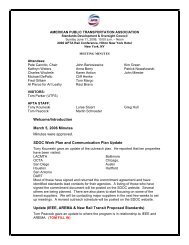Standard Bus Procurement Guidelines - APTAStandards.com
Standard Bus Procurement Guidelines - APTAStandards.com
Standard Bus Procurement Guidelines - APTAStandards.com
You also want an ePaper? Increase the reach of your titles
YUMPU automatically turns print PDFs into web optimized ePapers that Google loves.
<strong>Standard</strong> <strong>Bus</strong> <strong>Procurement</strong> <strong>Guidelines</strong><br />
5.5.3 WIRING AND TERMINALS<br />
All wiring between electrical <strong>com</strong>ponents and terminations, shall have double electrical insulation, shall<br />
be waterproof, and shall conform to specification requirements of SAE Re<strong>com</strong>mended Practice J1127<br />
and J1128. Except as interrupted by the master battery disconnect switch, battery and starter wiring shall<br />
be continuous cables, grouped, numbered, and/or color-coded with connections secured by bolted<br />
terminals; and shall conform to specification requirements of SAE <strong>Standard</strong> J1127-Type SGT or SGX<br />
and SAE Re<strong>com</strong>mended Practice J541. Wiring harnesses shall not contain wires of different voltages<br />
unless all wires within the harness are sized to carry the current and insulated for the highest voltage wire<br />
in the harness.<br />
Double insulation shall be maintained as close to the terminals as possible. The requirement for double<br />
insulation shall be met by wrapping harnesses with plastic electrical tape or by sheathing all wires and<br />
harnesses with non-conductive, rigid or flexible conduit. Strain-relief fittings shall be provided at points<br />
where wiring enters all electrical <strong>com</strong>ponents. Grommets of elastomeric material shall be provided at<br />
points where wiring penetrates metal structures outside of electrical enclosures. Wiring supports shall be<br />
protective and non-conductive at areas of wire contact and shall not be damaged by heat, water, solvents,<br />
or chafing.<br />
All wiring harnesses over 5 feet long and containing at least 5 wires shall include 10 percent excess<br />
wires for spares that are the same size as the largest wire in the harness excluding the battery cables.<br />
Wiring length shall allow end terminals to be replaced twice without pulling, stretching, or replacing the<br />
wire. Except for large wires such as battery cables, terminals shall be crimped to the wiring and may be<br />
soldered only if the wire is not stiffened above the terminal and no flux residue remains on the terminal.<br />
Terminals shall be corrosion-resistant and full ring type or interlocking lugs with insulating ferrules. T<br />
splices may be used when there is less than 25,000 circular mills of copper in the cross section and a<br />
mechanical clamp is used in addition to solder on the splice; the wire supports no mechanical load in the<br />
area of the splice; and the wire is supported to prevent flexing.<br />
All cable connectors shall be locking type, keyed, and watertight, unless enclosed in watertight cabinets.<br />
Pins shall be removable, crimp contact type of the correct size and rating for the wire being terminated.<br />
Unused pin positions shall be sealed with sealing plugs. Adjacent connectors shall either use different<br />
inserts or different insert orientations to prevent incorrect connections.<br />
5.5.4 JUNCTION BOXES<br />
All relays, controllers, flashers, circuit breakers, and other electrical <strong>com</strong>ponents shall be grouped<br />
according to voltage; and mounted in easily accessible junction boxes. The boxes shall be sealed to<br />
prevent moisture from normal sources, including engine <strong>com</strong>partment cleaning, from reaching the<br />
electrical <strong>com</strong>ponents and shall prevent fire that may occur inside the box from propagating outside the<br />
box. The <strong>com</strong>ponents and circuits in each box shall be identified and their location permanently<br />
recorded on a schematic drawing glued to or printed on the inside of the box cover or door. The drawing<br />
shall be protected from oil, grease, fuel, and abrasion. The front junction box shall be <strong>com</strong>pletely<br />
serviceable from the driver's seat, vestibule, or from outside. A rear start and run control box shall be<br />
mounted in an accessible location in the engine <strong>com</strong>partment.<br />
Technical Specifications 191 10/18/07


